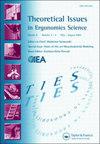The frequency of facial muscles engaged in expressing emotions in people with visual disabilities via cloud-based video communication
IF 1.4
Q4 ERGONOMICS
引用次数: 0
Abstract
Abstract As technology is advancing quickly, and various assistive technology applications are introduced to users with visual disabilities, many people with visual disabilities use smartphones and cloud-based video communication platforms such as Zoom. This study aims at advancing knowledge of how people with visual disabilities visualize voluntary emotions via facial expressions, especially in online contexts. A convenience sample of 28 participants with visual disabilities were observed as to how they show voluntary facial expressions via Zoom. The facial expressions were coded using the Facial Action Coding System (FACS) Action Units (AU). Individual differences were found in the frequency of facial action units, which were influenced by the participants’ visual acuity levels (i.e., visual impairment and blindness) and emotion characteristics (i.e., positive/negative valence and high/low arousal levels). The research findings are anticipated to be widely beneficial to many researchers and professionals in the field of facial expressions of emotions, such as facial recognition systems and emotion sensing technologies. Relevance to human factors/ergonomics theoryThis study advanced knowledge of facial muscle engagements while people with visual disabilities visualize their emotions via facial expressions, especially in online contexts. The advanced understanding would contribute to building a fundamental knowledge foundation, ultimately applicable to universal designs of emotion technology that can read users’ facial expressions to customize services with the focus on adequately accommodating the users’ emotional needs (e.g., ambient intelligence) regardless of users’ visual ability/disability.通过基于云的视频通信,视觉障碍人士面部肌肉表达情绪的频率
摘要随着技术的快速发展,各种辅助技术应用被引入视障用户,许多视障人士使用智能手机和Zoom等基于云的视频通信平台。这项研究旨在提高视障人士如何通过面部表情,特别是在网络环境中,将自愿情绪可视化的知识。对28名视觉残疾参与者的便利样本进行了观察,了解他们如何通过Zoom显示自愿的面部表情。使用面部动作编码系统(FACS)动作单元(AU)对面部表情进行编码。面部动作单元的频率存在个体差异,这受到参与者的视力水平(即视觉障碍和失明)和情绪特征(即积极/消极效价和高/低唤醒水平)的影响。预计这项研究结果将对面部表情领域的许多研究人员和专业人士广泛有益,如面部识别系统和情感传感技术。与人为因素/人机工程学理论的相关性这项研究提高了面部肌肉活动的知识,而视障人士则通过面部表情来表达自己的情绪,尤其是在网络环境中。先进的理解将有助于建立一个基础知识基础,最终适用于情感技术的通用设计,该技术可以读取用户的面部表情来定制服务,重点是充分满足用户的情感需求(例如,环境智能),而不考虑用户的视觉能力/残疾。
本文章由计算机程序翻译,如有差异,请以英文原文为准。
求助全文
约1分钟内获得全文
求助全文

 求助内容:
求助内容: 应助结果提醒方式:
应助结果提醒方式:


